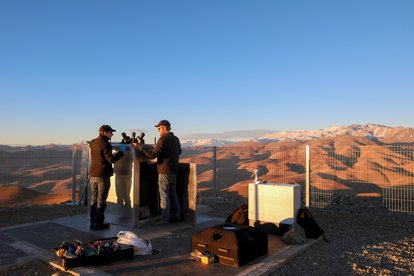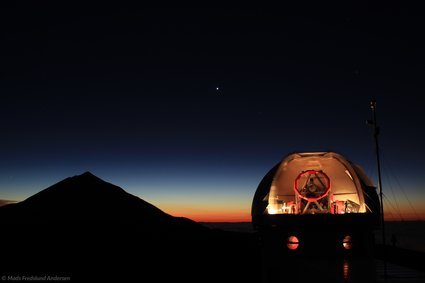Two new exoplanets confirmed by the Danish SONG telescope
The Dutch camerasystem MASCARA and the Danish 1-metre telescope SONG on Tenerife, supplement each other in the discovery of two new 'hot jupiters'.

There are exoplanets galore of various types orbiting most other stars. We are now quite sure of this. Next step will be the study of the atmospheres surrounding these planets, whith the clear end target: finding life. For this enormous telescopes are not nescessarily needed. Two minor telescopes have recently shown the great strength to be found in collaboration. They are the camerasystem MASCARA and the Danish 1-metre telescope SONG on Tenerife, having supplemented each other in the discovery of two new 'hot jupiters'.
In two recent papers authored a.o. by astronomers from Stellar Astrophysics Centre af Aarhus University the discovery of two new gas planets closely orbiting the stars MASCARA-1 and MASCARA-2 is reported. The MASCARA cameras are able to measure slight changes in the luminosity of bright stars. Regular luminosity changes may be a sign of heavy planets orbiting the stars, though other interpretations are also possible. Measurements with the high precision spectrograph mounted at the Hertzsprung SONG telescope can diminish the risk of erroneous interpretations of the data, and now the workgroup of astronomers are sufficiently sure of the results that two papers are published on arXiv.
Studying exoplanetary atmospheres
The two new confirmed planets MASCARA-1b and MASCARA-2b are ideel for further studies of the composition of gasses in the planetary atmospheres. The host stars are very stable, making the analysis much easier.
Already this has been tried with MASCARA-1b and the second planet will make a perfect target for the James Webb Space Telescope to be launched in 2018. Observing these exoplanetary atmospheres is mostly a proof of concept, showing that the techniques will work. There are no serious expectations of life here, at the surface temperatures amount to some 2570 degrees.
The La Silla MASCARA unit during installation in 2017. Not much to look at. credit: ESO
In the eyes of MASCARA
Looking at MASCARA you would not immediately recognize it as an advanced astronomical telescope. It is just a group of five standard off the shelf cameras with wide angle lenses mounted together in an array. In addition to what anyone could buy in a camera shop there is some specially developed software. In total the lenses cover almost all of the visible sky at the same time. All-sky pictures are recorded with intervals of a few minutes through the night and night after night. The first MASCARA array is in operation on the Roque de los Muchachos Observatory on La Palma in the Canaries, and the next setup is at present being tested at ESO's La Silla Observatory in Chile. Three more MASCARAs are in planning, ensuring a continouus coverage of all of the starry sky. The cameras measure the minute dips in stellar brightness due to an exoplanet transiting in front of the star, causing a partial eclipse.
The Hertzsprung SONG telescope awaiting orders. Teide is in the background, keeping quiet. credit: Mads F. Andersen
A SONG of the stars
A telescope having a 1m main mirror diameter is nothing special in the world of astronomy. What makes the SONG telescope rather special is that it is placed at one of the best sites in the World, and that it is a fully automated robotic telescope equipped with a high resolution spectrograph. With this instrument starlight can be split with a resolution sufficiently high to show the wobbling of a star in respect to observers at Earth. If this wobbling change in radial velocity is regular, it means that one or more exoplanets are orbiting the star.
One can study the atmosphere of a transiting exoplanet by subtracting two starlight spectra. One will only contain the light of the star, while the other on top of that will contain traces of light that has passed through the atmosphere of the exoplanet, being affected by molecules in the atmosphere.
Combining measurements from MASCARA and SONG enables the astronomers to confirm the excistence of these exoplanets, learning much more about the newly discovered planets than it would be possible with only one instrument.
PhD student Anders B. Justesen from Stellar Astrophysics Centre at Aarhus University is second author on the MASCARA-2b paper. He elaborates on the discovery: "Our observations with the spectrograph on SONG not only confirm that there actually is a heavy planet orbiting the star - in May and June 2017 we were able precisely to identify the spectral class of the star, and the diametres for both star and planet. In addition to this, we have determined an upper limit to the mass of the planet. SONG is a fantastic opportunity for young researchers to participate right in the frontline of the hunt for exoplanets."
The new hot Jupiters
MASCARA-1b is 1,5 times bigger than Jupiter, and almost 4 times heavier. Its orbit is very oblique and the period is a bit more than two days.
MASCARA-2b has a more flat orbit of 3,5 days and is somewhat bigger; with a diameter of 2,2 times that of Jupiter and a mass that might be up to 15 times this largest planet in our Solar System. Another research team has discovered this exoplanet simultaneously and their name for it is Kelt 20B.
Further information
Anders B. Justesen, and Mads Fredslund Andersen, who has the technical responsibility for the SONG-telescope, and is co-author on both papers, can be contacted at justesen@phys.au.dk and madsfa@phys.au.dk respectively for further background information.
Links to the two papers in arXive:
MASCARA-1 b: A hot Jupiter transiting a bright V=8.3 A-star in a misaligned orbit
MASCARA-2 b: A hot Jupiter transiting a V=7.6 A-star


